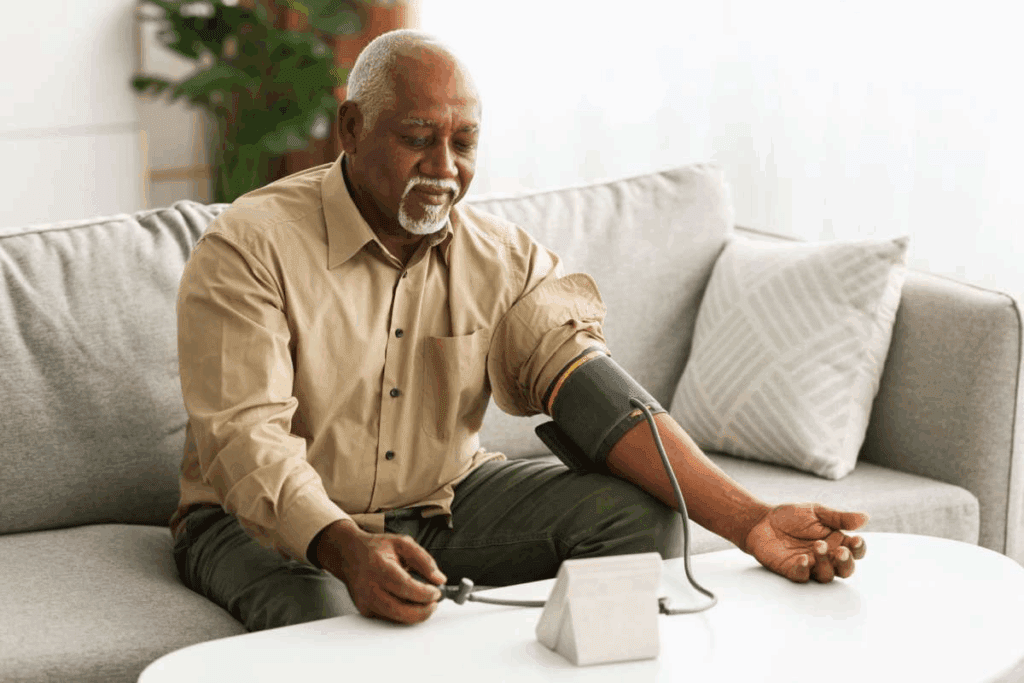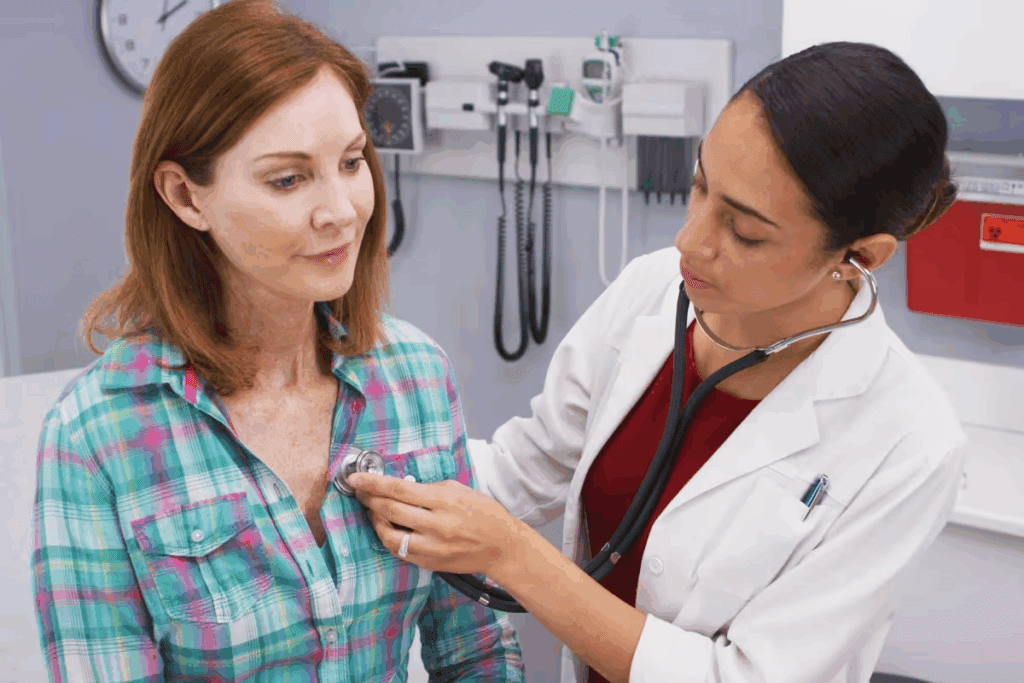Last Updated on November 25, 2025 by Ugurkan Demir

Understanding cardiac rhythm is key to keeping your heart healthy. The heart’s rhythm is the pattern and rate of electrical impulses. These impulses help the heart beat in sync, making sure blood flows well throughout your body. At Liv Hospital, we focus on keeping your heart working right. We offer top-notch, patient-focused care for managing heart rhythms.
An abnormal heart rhythm, or arrhythmia, happens when the heart beats too fast, too slow, or not right. Many things can mess with the heart’s complex system, causing arrhythmias. We’re here to help with all you need, from support to advanced medical treatments, for patients from around the world.

Cardiac rhythm is the pattern of electrical activity that controls our heartbeat. It’s vital for our health. Knowing about it helps us understand its role in our well-being and how it connects with heart rate.
Our heart’s rhythm is more than just a beat. It’s a complex process of muscle contraction and relaxation. This is all thanks to electrical signals that help the heart pump blood efficiently. The right rhythm is key for delivering oxygen and nutrients to our body’s tissues and organs.
An abnormal heart rhythm, or arrhythmia, can cause discomfort and other symptoms. These include palpitations, chest pain, and shortness of breath. Such symptoms can be a sign of serious health issues that need medical care.
“The heart’s rhythm is a critical indicator of cardiovascular health, and disturbances in this rhythm can signal a range of possible health problems.”
To keep your heart rhythm healthy, make lifestyle changes. This includes regular exercise, a balanced diet, and managing stress. Also, don’t forget to get regular check-ups to monitor your heart health.
Heart rate and rhythm are closely linked but different aspects of heart function. Heart rate is the number of beats per minute (bpm). Rhythm is the pattern of these beats. A normal rhythm is consistent, while an abnormal one can be irregular, too fast, or too slow.
| Heart Rate Category | Age Group | Normal Heart Rate Range (bpm) |
| Newborn | 0-1 month | 100-160 |
| Infant | 1-12 months | 80-120 |
| Child | 1-10 years | 70-130 |
| Adult | >10 years | 60-100 |
It’s important to understand the link between heart rate and rhythm for diagnosing and managing heart conditions. Doctors use tools like electrocardiograms (ECGs) to check both the rate and rhythm of the heart.

Understanding cardiac rhythm in medical terms is key. It involves knowing its impact on heart function and the factors that affect it. Cardiac rhythm is the pattern of electrical activity that controls the heartbeat. It determines how often the heart beats and how well it pumps blood.
In medical practice, cardiac rhythm is defined by the sequence of electrical impulses that control the heart’s contraction and relaxation. This sequence comes from the heart’s electrical conduction system. Knowing the terms related to cardiac rhythm is vital for diagnosing and treating heart rhythm disorders.
Terms like arrhythmia describe abnormal heart rhythms. Bradycardia and tachycardia refer to heart rates that are too slow or too fast. Other important terms include atrial fibrillation and ventricular fibrillation, which are specific arrhythmias.
It’s important to tell normal from abnormal cardiac rhythms for patient care. A normal rhythm, or sinus rhythm, has a heart rate between 60 and 100 beats per minute in adults. It also shows a normal P wave, QRS complex, and T wave on an electrocardiogram (ECG).
| Type of Rhythm | Characteristics | Clinical Significance |
| Normal Sinus Rhythm | 60-100 bpm, normal P wave, QRS, and T wave | Indicates healthy heart function |
| Tachycardia | Heart rate > 100 bpm | May indicate stress, anxiety, or underlying heart disease |
| Bradycardia | Heart rate | May be normal in athletes or indicate conduction system disease |
| Atrial Fibrillation | Irregularly irregular rhythm, absent P wave | Increases risk of stroke and heart failure |
Abnormal cardiac rhythms, or arrhythmias, can stem from heart disease, electrolyte imbalances, or certain medications. Accurate diagnosis with tools like ECG and Holter monitors is critical for proper management.
The heart’s electrical system is key to a normal heartbeat. It sends out electrical signals that make the heart beat in sync. This ensures the heart contracts and relaxes properly.
The heart’s electrical system has several important parts. These include the SA node, AV node, Bundle of His, and Purkinje fibers. Together, they help electrical impulses move through the heart.
The SA node in the right atrium starts the electrical impulses. These signals then go to the AV node, where they pause. This pause lets the atria contract first. The signals then move to the ventricles through the Bundle of His and Purkinje fibers, making them contract.
Electrical signals make the heart muscle cells contract. This synchronized contraction is vital for blood flow. The heart’s electrical system ensures this happens smoothly.
The process works like this:
This coordinated effort is essential for a normal heartbeat. It helps the heart pump blood efficiently.
| Component | Function |
| SA Node | Initiates electrical impulses |
| AV Node | Delays electrical impulses |
| Bundle of His | Transmits impulses to ventricles |
| Purkinje Fibers | Distributes impulses to ventricular muscle cells |
Knowing about the heart’s electrical system is vital for diagnosing and treating heart rhythm problems. It helps doctors understand how to manage irregular heartbeats.
The normal heart rhythm, or normal sinus rhythm, shows how well our heart is working. It has a steady heart rate and follows a specific pattern. We will look at what makes a healthy heart rhythm and the usual heart rate for different ages.
A healthy heart rhythm comes from the sinoatrial (SA) node, our heart’s natural leader. This rhythm has consistent and coordinated electrical activity. This leads to a regular heartbeat.
The main signs of a normal sinus rhythm are:
Heart rate ranges change with age. Knowing these ranges helps doctors diagnose and treat heart issues.
| Age Group | Normal Heart Rate Range (bpm) |
| Newborns (0-1 month) | 100-160 |
| Infants (1-12 months) | 80-120 |
| Toddlers (1-2 years) | 80-120 |
| Children (6-12 years) | 70-100 |
| Adults | 60-100 |
| Athletes | 40-60 |
Athletes or very fit people might have a lower heart rate at rest. This is because their heart works more efficiently.
We’ve talked about the key role of normal sinus rhythm. Knowing about it helps keep our heart healthy and spot problems early.
It’s important to know about the different cardiac rhythms to diagnose and treat heart issues. These rhythms come from various sources and have unique features. We’ll look at sinus rhythm changes, atrial rhythms, and ventricular rhythms.
Sinus rhythm, or normal sinus rhythm, starts in the sinoatrial (SA) node. It can change due to health reasons or diseases.
Atrial rhythms start in the atria, the heart’s upper chambers. They can be normal or abnormal.
| Rhythm Type | Description | Characteristics |
| Atrial Fibrillation | A rapid and irregular heart rhythm | Irregularly irregular rhythm, often with a rapid ventricular response |
| Atrial Flutter | A regular, rapid heart rhythm | Characteristic “sawtooth” pattern on ECG, often with a fixed block |
Ventricular rhythms start in the ventricles, the heart’s lower chambers. These are often linked to serious heart problems.
Examples include:
Knowing these cardiac rhythm examples is key for healthcare professionals. It helps them diagnose and manage heart conditions well. By recognizing rhythm characteristics, we can offer the right care and treatment.
The rhythm and rate of the heartbeat come from a mix of different body processes. At the center of this is the autonomic nervous system. It is key in controlling how the heart works.
The autonomic nervous system has two parts: the sympathetic and parasympathetic systems. The sympathetic nervous system makes the heart beat faster. This gets the body ready for action.
The parasympathetic nervous system slows the heart down. It helps the body relax and lowers stress.
This balance between the two systems lets the heart rate change as needed. For example, when we exercise, the sympathetic system kicks in to increase heart rate. When we rest, the parasympathetic system slows it down to save energy.
Hormones and chemicals also play a big role in heart rhythm. Hormones like adrenaline and thyroid hormones can change heart rate and rhythm. Adrenaline, for instance, makes the heart beat faster and stronger, getting us ready for stress.
Changes in chemicals, like electrolytes (like potassium, sodium, and calcium), can also affect the heart. For example, too much or too little potassium can cause irregular heartbeats.
Knowing about these factors helps us understand how the heartbeat is controlled. It also shows how problems can lead to heart rhythm issues or other heart problems.
Cardiac arrhythmias are when the heart beats irregularly. This can be too slow, too fast, or irregular. Symptoms include palpitations, shortness of breath, and feeling lightheaded. The treatment varies based on the type and cause.
Bradyarrhythmias happen when the heart beats less than 60 times per minute. This can cause fatigue, dizziness, and fainting. It’s important to find the cause to choose the right treatment.
We use electrocardiograms (ECGs) to diagnose bradyarrhythmias. They help us see the heart’s electrical activity. Sometimes, we use pacemakers to help the heartbeat stay regular.
Tachyarrhythmias occur when the heart beats too fast, over 100 times per minute. Symptoms include palpitations, chest pain, and shortness of breath. There are different types, each needing its own treatment.
We use ECGs and other tools to diagnose tachyarrhythmias. Treatment might include medicines or procedures like cardioversion.
Irregular heart rhythms, or arrhythmias, can be caused by many things. These include heart disease, imbalances in electrolytes, and some medicines. They can cause symptoms like palpitations and shortness of breath.
| Type of Arrhythmia | Characteristics | Common Symptoms | Treatment Options |
| Bradyarrhythmias | Slow heart rate (<60 bpm) | Fatigue, dizziness, fainting | Pacemakers |
| Tachyarrhythmias | Fast heart rate (>100 bpm) | Palpitations, chest pain, shortness of breath | Medications, cardioversion |
| Irregular Rhythms | Irregular heartbeat | Palpitations, shortness of breath | Medications, lifestyle changes |
Knowing about different cardiac arrhythmias is key to good care. By understanding the specific type and cause, doctors can create better treatment plans. This helps manage symptoms and improves patient health.
It’s important to know about atrial fibrillation and other arrhythmias for good heart care. Atrial fibrillation is a common condition with fast and irregular heartbeats. It can really hurt a patient’s health and raise the chance of stroke.
Atrial fibrillation happens when the heart’s electrical signals go haywire. This makes the atria quiver in an irregular way. It not only makes the heart less efficient but also raises the risk of blood clots. The risk of stroke is much higher in people with atrial fibrillation, so stopping blood clots is key.
The cause of atrial fibrillation is complex. Things like high blood pressure, heart failure, and heart valve problems can lead to it. Knowing these causes helps doctors find the right treatment.
Other arrhythmias also affect health a lot. These include:
Each arrhythmia has its own treatment. For example, atrial flutter and SVT might be treated with procedures or medicines. But VT often needs more serious steps, like ICDs.
We need to understand the different effects and treatments for these arrhythmias. By knowing how atrial fibrillation and other arrhythmias work, doctors can give better care. This helps improve how patients do.
Diagnosing cardiac rhythm disorders uses several key technologies and methods. It requires a detailed approach to accurately assess the heart’s electrical activity. Various diagnostic tools are used to get a full picture of the heart’s rhythm and rate.
An electrocardiogram, or ECG or EKG, is the top tool for diagnosing heart rhythm disorders. It records the heart’s electrical signals, giving vital info on the heart’s rhythm and rate. Doctors say, “ECG is the most used tool for heart rhythm checks because it’s simple and works well.”
“The ECG is a fundamental tool in cardiology, giving quick insights into the heart’s electrical activity.”
The ECG is non-invasive and gives results right away. It’s a key tool for checking arrhythmias like atrial fibrillation and ventricular tachycardia.
For those with symptoms that come and go, Holter monitors and event recorders are used. A Holter monitor records the heart’s activity for 24 to 48 hours. It shows the heart’s rhythm during daily life. Event recorders are used for longer periods and can be turned on by the patient when symptoms happen.
Holter monitors are great for catching arrhythmias that a standard ECG might miss. They give a detailed log of the heart’s activity, helping doctors diagnose rhythm disorders better.
There are also advanced technologies for checking cardiac rhythm. These include echocardiograms, which use sound waves to make heart images, and stress tests, which check the heart’s function when stressed.
These new tools give a deeper look at the heart’s structure and function. They help diagnose complex rhythm disorders. As technology gets better, diagnosing and managing heart rhythm disorders gets more precise.
Cardiac rhythm disorders are treated with a mix of medicines, procedures, and devices. We tailor our approach to each patient’s needs. This ensures their condition is well-managed.
Medicines are key in treating heart rhythm issues. Beta-blockers help slow the heart rate and make contractions weaker. Anti-arrhythmic medications work to fix the heart’s rhythm and stop irregular beats.
Calcium channel blockers and digoxin are used too. They help control heart rate and improve function. The right medicine depends on the disorder, the patient’s health, and more.
When medicines don’t work, we turn to procedures and devices. Catheter ablation uses energy to destroy bad heart pathways.
Pacemakers and implantable cardioverter-defibrillators (ICDs) are implanted to manage heart rhythms. Pacemakers keep the rhythm steady. ICDs shock the heart back to normal if it’s life-threatening.
Cardioversion is another procedure. It uses an electric shock to fix the rhythm. These treatments often work together with medicines for the best results.
Keeping a healthy cardiac rhythm is key for good heart health. We’ve looked at what cardiac rhythm is, why it matters, and what affects it.
Changing our lifestyle can help a lot. Eating right, exercising, and managing stress are all good for our heart rhythm. Knowing how to support our heart rhythm can lower the risk of heart rhythm problems.
By focusing on heart health, we can keep our rhythm in check. This improves our life quality and supports our health for the long run. As we learn more about heart health, it’s clear that a healthy cardiac rhythm is essential.
Cardiac rhythm is the pattern of electrical activity that controls the heartbeat. It’s key for the heart to work right, pumping blood well throughout the body.
In medical terms, cardiac rhythm is the sequence of electrical impulses that control the heart’s contraction and relaxation. It’s measured with electrocardiography (ECG/EKG) and is described by its rate, regularity, and shape.
Adults usually have a heart rate between 60-100 beats per minute (bpm). Newborns have a faster rate (100-160 bpm), and older adults might have a slower rate.
The autonomic nervous system, with its sympathetic and parasympathetic branches, is vital in controlling heart rhythm. It adjusts the heart rate and force in response to needs and stress.
Arrhythmias include slow, fast, and irregular heart rhythms. Treatment depends on the type and severity. It can involve medications, procedures, or devices like pacemakers or ICDs.
Atrial fibrillation is diagnosed with ECG/EKG or Holter monitoring. Treatment may include medications, cardioversion, and anticoagulation to prevent stroke.
Tests like ECG/EKG, Holter monitors, and event recorders measure cardiac rhythm. Advanced technologies like cardiac mapping and implantable loop recorders are also used.
A normal sinus rhythm has a consistent heart rate of 60-100 bpm. It shows a normal P-wave and PR interval, indicating proper electrical conduction.
Hormones, like thyroid hormones, can greatly affect heart rhythm. They influence the heart’s electrical activity and the autonomic nervous system’s control.
A healthy cardiac rhythm is essential for proper heart function. It helps prevent heart disease and reduces risks of stroke, heart failure, and sudden death.
Subscribe to our e-newsletter to stay informed about the latest innovations in the world of health and exclusive offers!